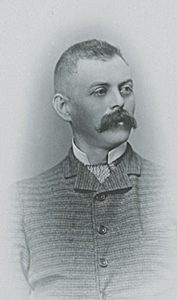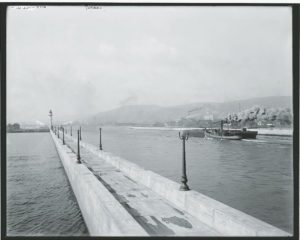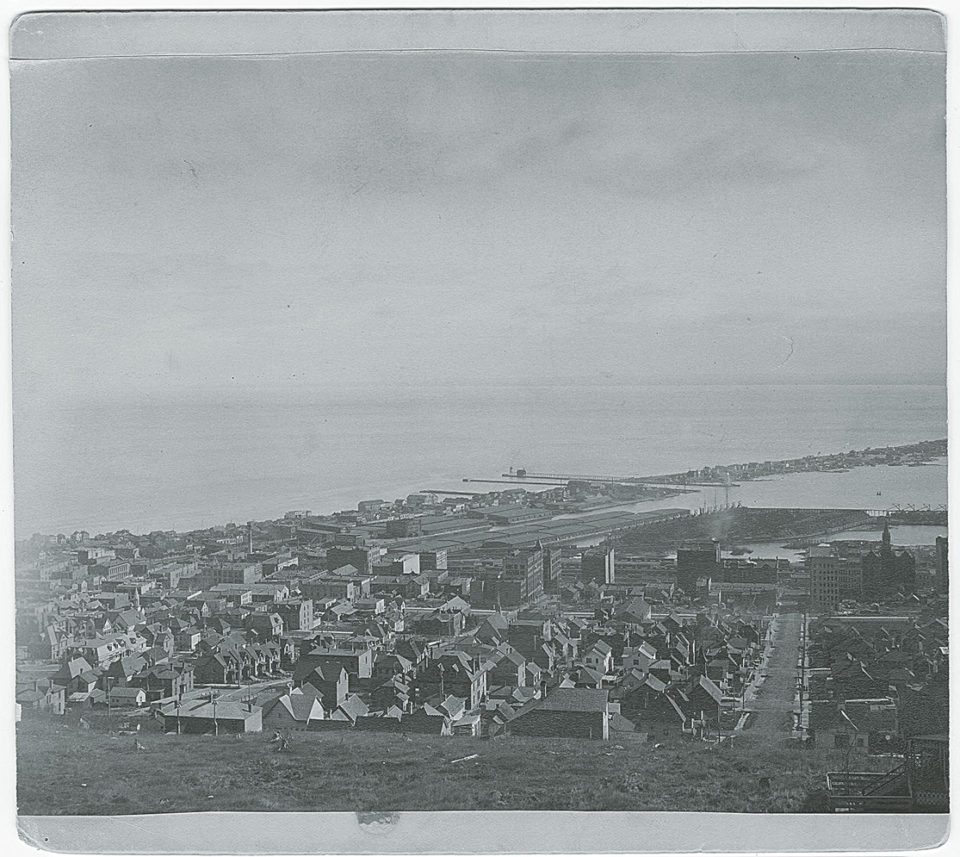The Boeing Company is one of the world’s largest manufacturers of commercial aircraft, with a net worth of more than $150 billion (2021). It was founded on July 15, 1916 in Seattle, Washington by William Edward Boeing as Pacific Aero Products Company, renamed a year later to Boeing Airplane Company.
So, what’s the Boeing connection to the Northern Wilds?
Well, back in the 1880s, it was William’s father, Wilhelm Boeing who was in the national spotlight when he claimed to own part of the Duluth Canal and tried to stop ships from entering.
Born in 1846 in Hohenlimburg, Germany, Wilhelm immigrated to the U.S. in 1868, arriving broke. He anglicized his name to Boeing, settled in Detroit, worked for lumberman Karl Ortmann, and married the boss’s daughter Marie Ortmann. They had two children: William (founder of Boeing) and Caroline.
Not long after marrying, Wilhelm started buying timberland around Lake Superior (including 7,500 acres around today’s town of Chisholm) and securing mineral rights on his properties on Minnesota’s Mesabi Range (his Boeing Mine in the Mesabi Range was located north of Hibbing in what is now the Hull-Rust mine pit). He became a wealthy man with his holdings in land, timber and mining rights. Meanwhile, he continued to live in Detroit, having built a stately mansion there. When he died of influenza in 1890 at age 42, his estate was worth $2 million (2021 value of $60.7 million).
His land purchases included 14 lots on Minnesota Point. When the Duluth Ship Canal was created, the canal had been built through his property leaving his land on both sides of the canal. In 1888, he began actions to get his land back. Rumours swirled that he planned to charge ships a toll. However, Wilhelm told the Superior Times (October 19, 1889) that “his intention was to establish his right to the fourteen lots in the canal.” The end goal was for the City of Duluth to buy his canal property, which he valued at $100,000 (2021 value of $2.9 million). In the fall of 1889, Wilhelm set about to enforce his ownership.

On September 27, 1889, Wilhelm signed a warning notice that appeared in Duluth newspapers. It was also distributed to shipping companies and to vessels at the Sault Ste Marie locks headed to Duluth. It read:
You are hereby notified that on and after the 15th day of October 1889, the right of passage through the canal connecting the waters of Lake Superior and the Bay of Duluth will be denied by me to all boat and vessel owners.
A rope will be stretched across said canal upon my property, which lies in and upon either side of the said canal, and the owner or master of any boat or vessel breaking the same will be promptly proceeded against in the courts.
September 27, 1889
WILHELM BOEING.
With no offer forthcoming from the city to purchase his land, Wilhelm apparently telegraphed his Duluth lawyer Marshall H. Alworth on October 14, 1889 and gave the order, “String the Rope.” Alworth hired Ferryman Charles Winters and assistants Frank Jacobs and James Jones to do the work. Shortly after midnight on October 15, the men attached a half-inch rope to the canal’s piling on one side, stretched it across the canal by ferry and secured it to the piling on the other side. However, the work was for naught as the police arrived and cut the rope.
A few hours later, the men again stretched the rope across the canal. About 7:30 a.m. the propeller vessel Winslow entered the canal, the captain ignored the Boeing warning and the Winslow steamed through, breaking the rope. Again, the men strung the rope across the canal. A short while later, the tug Spirit—towing two scows—was “brought to a standstill by the rope” until someone from the tug cut the line and Spirit continued on with its tow.

Boeing’s men didn’t give up. According to the St. Paul Daily Globe (October 16, 1889), the men “succeeded in spiking a long piece of chain to the side of the canal timbers and announced their determination of attaching a rope to the end of the chain in such a manner as to prevent its being cut from the side of the canal.” That didn’t work out too well as, supposedly, they didn’t attach the rope to the chain.
Putting an end to the shenanigans, a special unit of police were posted to the canal about 9:30 a.m. with orders from the Duluth Chief of Police to arrest anyone who tried to put a rope across the Duluth Canal.
St. Paul Daily Globe also reported that “The general belief is that Mr. Boeing has valid title to the lots and that he will force the City of Duluth to pay the full claim for the valuable property taken without his consent and used for a long term of years.”
When Wilhelm Boeing died the following year in May, the Duluth Canal matter remained unresolved and there is no record of any payment made to him or his estate. And his 14 lots? According to reports, they are now either part of the canal, its piers or Canal Park.






